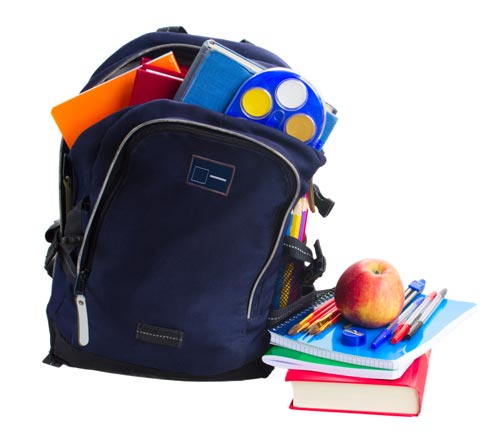Watch That Backpack Load
 With kids back in school, parents and students should make sure heavy backpacks aren't too much of a burden. Young children are suffering from back pain much earlier than previous generations, and the use of overweight backpacks is considered to be a contributing factor. This new back pain trend among children and teens isn't surprising when you consider the disproportionate amounts of weight they carry in their backpacks - often slung over just one shoulder.
With kids back in school, parents and students should make sure heavy backpacks aren't too much of a burden. Young children are suffering from back pain much earlier than previous generations, and the use of overweight backpacks is considered to be a contributing factor. This new back pain trend among children and teens isn't surprising when you consider the disproportionate amounts of weight they carry in their backpacks - often slung over just one shoulder.
Most children rely on backpacks to carry books and supplies to and from school and activities. But a backpack that’s too heavy or doesn’t fit right can cause harm.
"When used correctly, backpacks can be a good way to carry the necessities of the school day," says Queta Almanza, injury prevention specialist at Driscoll Children's Hospital. "Backpack injuries are commonly caused by wearing overloaded backpacks, as well as lifting and carrying them incorrectly. Parents and teachers should guide kids to take preventative measures. Start by choosing a backpack that is appropriately sized for your child or have them use a rolling backpack as an alternative to carrying their heavy load on their shoulders." Queta says that you should also check with your child's school to ensure that his/her backpack conforms to school regulations or policies.
Children can hurt themselves by using poor posture to carry a heavy bag. They may arch their back, bend forward, twist or lean to one side. These positions can change the spine’s alignment so its disks can’t absorb shocks as they should. It can injure muscles and joints in the back, neck and shoulders. It can cause problems with posture and may even cause nerve damage.
Choosing the right backpack
 Pick a backpack for your child that:
Pick a backpack for your child that:
-
Is lightweight but strong
-
Has two wide, padded shoulder straps (not just one strap)
-
Has a padded back, to protect against sharp objects inside the bag
-
Has a waist strap, to help keep the bag stable
What about rolling backpacks?
A rolling backpack can be useful if your child needs to carry heavy items. However, a rolling pack can be hard to carry up stairs. It may be hard to roll over bumpy ground or in snow. Think about how your child will need to use the bag. In some cases, it may not be the best choice.
Wearing a backpack safely
 Talk with your child about how to safely use a backpack. Help him or her adjust it. Teach your child to:
Talk with your child about how to safely use a backpack. Help him or her adjust it. Teach your child to:
-
Pack light. The backpack should be at a comfortable weight. Weigh it on a scale. When full, it shouldn’t be more than 10% to 20% of your child’s body weight.
-
Only carry what’s needed. Make sure your child knows not to carry a whole day’s books and supplies at once. Tell him or her to make trips to his or her locker during the day.
-
Use care when putting on and taking off the backpack. Your child should avoid twisting too much. When picking up a heavy backpack, your child should bend with both knees, not at the waist.
-
Use both straps on both shoulders. This is to help spread the weight and promote good posture. Tell your child not to sling both straps over one shoulder. This makes posture off-balance. It can even lead to a curved spine.
-
Position the backpack evenly in the middle of the back. The backpack should sit two inches above the waist. This will help prevent awkward postures.
-
Tighten and loosen the straps as needed. The straps should be snug when your child is wearing the pack. This helps hold the pack firmly to the body. He or she should then loosen the straps before removing the pack. This makes it easier to take off.
If your child has pain
Make sure to talk with your child about any discomfort from the backpack. If your child has pain from the bag, talk with the school about ways your child can have a lighter load. Make sure the school allows trips to lockers as needed. If the pain continues, talk with your child’s health care provider.
© 2000-2025 The StayWell Company, LLC. All rights reserved. This information is not intended as a substitute for professional medical care. Always follow your healthcare professional's instructions.